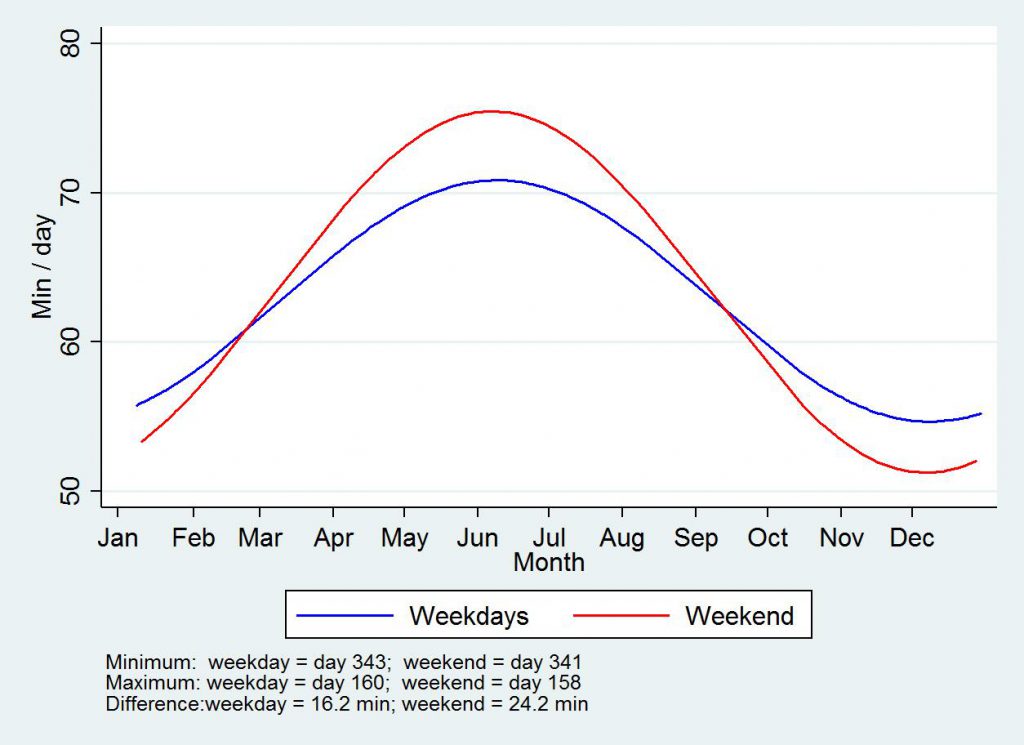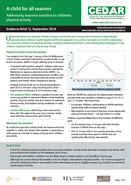Addressing seasonal variation in children’s physical activity – September 2016
Understanding how physical activity changes across the year is important because it helps identify periods when children might require additional support to be active. Our work at CEDAR is describing this seasonal variation in physical activity, exploring related behaviours, and investigating strategies to help children maintain their activity all year round.
Jump to:
- Physical activity across the seasons
- Whatever the weather?
- Gimme shelter?
- Night and day
- Implications for policies and interventions
- References and resources
Brief in brief
- In the UK, children’s physical activity shows seasonal variation. Activity levels are lower in autumn and winter, with more pronounced variation at the weekend, and in boys.
- Day length and weather conditions are the likely drivers of these patterns, but the effects vary by age.
- Although we cannot change the weather or hours of light, interventions may be possible – for instance support at school for physical activity in wet weather. More radical approaches to daylight savings (e.g. Double Summertime) would support activity.
Physical activity across the seasons
Our analysis from the Age 7 survey of the UK Millennium Cohort Study used data collected by accelerometer on up to five occasions within a single calendar year. It showed:
- Consistent with previous research, children were more active in spring and summer than autumn and winter. Moderate-to-vigorous physical activity (MVPA – i.e. that which requires a substantial amount of effort and noticeably increases the heart rate) was lower in both autumn and winter when compared to spring.
- Average activity levels across the group peaked in April at 65.3 min/day and dropped to their lowest levels in February at 47.8 min/day.
- The weekend effect: children’s weekend activity was more susceptible to seasonal influence than weekday activity. Physical activity was at its lowest at weekends during winter, and highest during weekends in early summer.
- Gender differences: whilst boys were more active than girls throughout the year, boys’ activity varied more with the seasons than girls’ activity.
Fig.1: Seasonal variation in children’s physical activity

Whatever the weather?
As might be expected, activity levels are lowest when the weather is colder and wetter. Wet weather in particular is often given as a barrier to being active by children and adults.
Work at CEDAR has explored the relationships between activity levels and rainfall in children at ages 9-10, 10-11, and 13-14 years. We found that:
- In younger children, participation in MVPA declined significantly with increased rainfall.
- Wet weather at any time of the year is associated with reduced activity levels – not just when it is colder.
Children respond differently to the weather at different ages:
- On the wettest days, 9-10 year olds did 14 fewer minutes of MVPA than on dry days.
- The 13-14 year olds in our sample were less active overall, but their time spent in MVPA was not significantly affected by wet weather
Gimme shelter?
The school environment can affect how children respond to the weather. Schools who allow their pupils to be active indoors during wet weather encourage greater activity than those who enforce outdoor play.
Pupils who were allowed to play ball games or running games indoors when it was raining did an average of 10 minutes more MVPA during lunchtime than children who were sent outdoors to play in the wet.
Night and day
Day length is also important to physical activity. Our research supports the assumption that longer daylight after school encourages greater activity levels in children.
With Bristol University, we analysed data from 23,000 children in the International Children’s Accelerometry Database (ICAD). We found clear evidence that more daylight in the afternoon encourages greater activity levels in children aged 5-16 in Australia and in a wide range of European countries, including Britain.
Among these children, each extra hour of afternoon daylight translates into around a 5% increase in activity levels. Although fairly modest at the individual level, this effect applies to each and every child in the country, and has the potential to generate substantial population-level benefits when combined with other efforts to encourage physical activity.
The effect of daylight also seems to be equitable, with comparable increases in physical activity observed regardless of the child’s gender, socio-economic background, or overweight/obesity status.
In a study of British children aged 8-11 years, conducted in collaboration with University College London, we found that the association between day length and physical activity was driven in particular by increases in out-of-home play on long summer evenings. Specifically the physical activity came from unstructured play away from the home.
Implications for policies and interventions
- Children require additional support to be active during the autumn and winter months. We cannot change the weather, but efforts to increase activity when it is raining may be most relevant at primary schools. This might include providing opportunities for indoor physical activity in wet weather.
- The structure of the school day, including the need for travel, to some extent protects against seasonal influences during weekdays in term time. Therefore, interventions focusing specifically upon weekends during winter may be particularly beneficial. This would require the involvement and support of families.
- Changing the timing and structure of the school day could make more daylight time available for children to be active throughout the year. This could be achieved through, for example, longer breaktimes during the day, or earlier finishes during the winter. Consideration of the impact on children’s opportunities for outdoor play and physical activity should be given to any proposed changes to school day structure and length.
- A more radical suggestion to reduce the effects of darker evenings would be to adopt “single/double Summer Time”, or other variations, as has been the case in the UK for periods of the 20th Century. There is some evidence of potential safety benefits of longer, lighter evenings. Other countries have different daylight savings arrangements: in the USA, for instance, clocks change earlier in the spring and later in the autumn, providing longer days for more of the year.
References and resources
Research papers
- Atkin, A. J. et al. (2016). Seasonal Variation in Children’s Physical Activity and Sedentary Time. Medicine & Science in Sports & Exercise 48(3): 449-456. www.ncbi.nlm.nih.gov/pubmed/26429733
- Harrison, F. et al. (2011). The impact of rainfall and school break time policies on physical activity in 9-10 year old British children: a repeated measures study. International Journal of Behavioral Nutrition and Physical Activity 8(47). https://ijbnpa.biomedcentral.com/articles/10.1186/1479-5868-8-47
- Harrison, F. et al. (2015). The changing relationship between rainfall and children’s physical activity in spring and summer: a longitudinal study. International Journal of Behavioral Nutrition and Physical Activity 12(41). https://ijbnpa.biomedcentral.com/articles/10.1186/s12966-015-0202-8
- Goodman, A. et al. (2014). Daylight saving time as a potential public health intervention: an observational study of evening daylight and objectively-measured physical activity among 23,000 children from 9 countries. International Journal of Behavioral Nutrition and Physical Activity 11(84). https://ijbnpa.biomedcentral.com/articles/10.1186/1479-5868-11-84
- Goodman, A. et al. (2011). Day length and weather effects on children’s physical activity and participation in play, sports and active travel. Journal of Physical Activity & Health 9(8). 1105-1116 www.ncbi.nlm.nih.gov/pmc/articles/PMC3584676/
Policy and guidance
- Daylight Savings Bill 2010-11. Private Members Bill, UK Parliament http://services.parliament.uk/bills/2010-12/daylightsaving.html
- HM Government (2015) Sporting Future: A New Strategy for an Active Nation www.gov.uk/government/uploads/system/uploads/attachment_data/file/486622/Sporting_Future_ACCESSIBLE.pdf
Please cite this Evidence Brief as: UKCRC Centre for Diet and Activity Research (CEDAR), Evidence Brief 12 – A child for all seasons – Addressing seasonal variation in children’s physical activity, September 2016. www.mrc-epid.cam.ac.uk/resources/policy-resources/evidence-briefs/eb-a-child-for-all-seasons/

 MRC Epidemiology Unit
MRC Epidemiology Unit